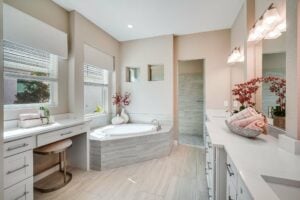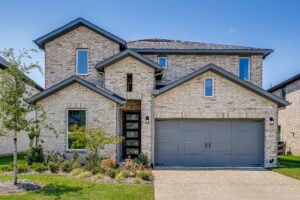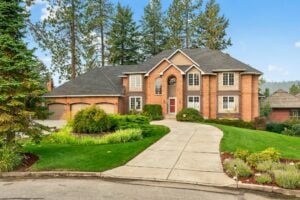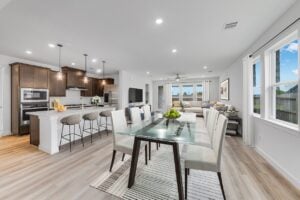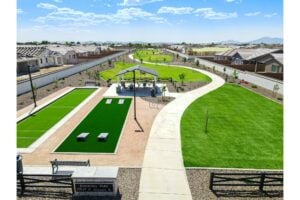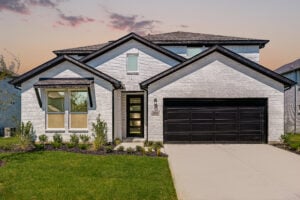Lifestyle photography is changing how real estate brands connect with buyers. Instead of showing empty rooms, it focuses on how people might live in a space, creating emotional connections that make properties feel like home. Listings with lifestyle photos get 40% more clicks, keep viewers engaged 3–5 times longer, and drive 65% more inquiries. Here’s why it works:
- Emotional Appeal: Photos show daily life moments like family breakfasts or relaxing on the patio, helping buyers imagine themselves in the home.
- Community Focus: Highlighting local parks, events, and amenities adds value by showcasing the lifestyle beyond the property.
- Personal Touches: Thoughtful staging with details like books or fresh flowers makes spaces feel inviting.
- Better Results: Homes with lifestyle photography sell faster and often for higher prices.
Quick Comparison: Traditional vs. Lifestyle Photography
| Traditional Photography | Lifestyle Photography |
|---|---|
| Focuses on empty rooms | Shows people enjoying the space |
| Highlights structure and details | Highlights emotions and experiences |
| Functional but impersonal | Warm and relatable |
Lifestyle photography is more than just pictures – it’s a way to help buyers see a house as their future home.
Lifestyle Photos for Realtors | Real Estate Marketing
5 Ways Lifestyle Photography Makes Real Estate Brands More Human
When real estate brands use lifestyle photography, they create stronger emotional connections with potential buyers by presenting properties as more than just structures – they become homes where life unfolds. Here are five ways this approach can make your brand feel more relatable and engaging through genuine imagery.
Show Real Daily Life Moments
Lifestyle photography shines when it captures everyday moments, helping buyers imagine their own routines in the space. Instead of focusing on empty rooms, show scenes that tell a story: a family laughing over breakfast at the kitchen island, someone curled up with a book in a sunny window nook, or a couple sipping coffee on the balcony. These relatable moments make it easier for buyers to picture themselves living there.
For example, close-ups of someone preparing a meal in a sleek kitchen, kids splashing in a backyard pool, or a serene morning on the patio can spark emotional connections. This is especially important since 89% of homebuyers say photos are the most helpful tool during their online property search. When buyers see joyful, everyday activities in a listing, it resonates on a personal level, making the property more memorable.
Beyond individual routines, showcasing the property’s connection to its surroundings adds another layer of appeal. Highlighting community life can help buyers see not just a home but a lifestyle.
Feature Community and Local Life
While intimate daily moments create a personal connection, community-focused images showcase the bigger picture. Highlighting local amenities, parks, and neighborhood culture helps buyers understand that they’re not just purchasing a property – they’re becoming part of a community.
Start by identifying what makes the neighborhood special. Does it have charming landmarks, scenic views, or vibrant local events like farmers markets or parades? Capturing these elements in your photos can give potential buyers a sense of the area’s character. For instance, showing families enjoying a local park or a bustling community event creates a vivid picture of what life in the neighborhood looks like.
Social media plays a huge role here. With 45% of buyers turning to social platforms for listings – and those leads being higher quality compared to traditional MLS – community-focused imagery can reach a highly engaged audience. Including real people in these shots makes them even more relatable. Show neighbors chatting, kids playing, or individuals enjoying shared spaces to emphasize the warmth and diversity of the community.
"By focusing on the community features, real estate professionals can paint a picture of the lifestyle it offers."
Use natural light to create vibrant, inviting photos that highlight the beauty of the area. Whether it’s joggers on tree-lined streets or families gathering at a playground, these images help buyers imagine themselves as part of the neighborhood.
Add Personal Touches to Interior Shots
Empty rooms can feel cold and impersonal, but thoughtful staging with personal touches can transform them into warm, inviting spaces. By adding small details – like books on a nightstand, fresh flowers on the dining table, or a cozy throw blanket on a couch – you can create a sense of home that resonates emotionally with buyers.
These subtle elements help buyers picture themselves living in the space. A kitchen counter set with fresh ingredients ready for a meal, a peaceful reading nook, or a tidy home office can all suggest a lifestyle of comfort and possibility. This is crucial because buying a home is often an emotional decision, driven by how a property makes someone feel.
The key is to keep it natural. Overly staged or perfect setups can feel artificial, while more authentic details create a sense of warmth and livability. When done right, these personal touches tell a story – not just about the property’s rooms and features but about the life that could unfold within its walls.
How to Take Better Lifestyle Real Estate Photos
Creating standout lifestyle real estate photos requires a mix of technical expertise and a clear vision. With over 90% of buyers starting their home search online, the quality of your images can significantly impact a listing’s success. Here’s how to produce photos that connect with potential buyers and elevate your listings.
Pick the Right Camera Equipment and Settings
The right equipment is crucial for capturing high-quality lifestyle photos. While smartphones have come a long way, professional cameras still offer the superior image quality and advanced features needed for real estate photography.
When choosing a camera, both mirrorless and DSLR models are excellent options. DSLRs are user-friendly and highly versatile, while mirrorless cameras are compact, fast, and great for video. For those on a budget, the Canon EOS Rebel SL3 at $749 is a solid entry-level choice. Mid-range options include the Nikon D3500 at $1,469.95 and the Canon EOS 250D at $879. For professional results, consider the Sony A7R III at $3,498 or the Canon EOS 5D Mark IV at $3,129.95.
Wide-angle lenses are a must for showcasing entire rooms and creating a sense of space. For full-frame cameras, use a 16–17mm lens; for cropped sensor models, go with a 12–15mm lens. These focal lengths provide a broad view while keeping proportions natural.
A tripod is another essential tool. It ensures sharp, stable shots, especially in low-light conditions. Position it at eye level and align vertical lines to give your photos a polished, professional feel.
For settings, aim for an aperture of f/8–f/11, ISO between 200–400, and a shutter speed around 1/125. Adjust these based on lighting conditions, and always shoot in RAW format to allow for maximum flexibility during editing.
Here’s a quick guide for different lighting situations:
- Well-lit interiors: Aperture f/8, ISO 400, aperture priority mode, and matrix metering.
- Dimly lit rooms: Similar settings but switch to spot metering.
- Bright outdoor shots: Aperture f/11, ISO 100.
- Night exteriors: Aperture f/8, ISO 200.
Once you’ve captured your shots, editing will help refine them and bring out their full potential.
Edit Photos to Look Natural
Editing is about enhancing your photos while keeping them authentic. Start with basic adjustments like exposure and contrast to make your images pop. Focus on achieving natural, true-to-life color tones through careful color correction that reflects the atmosphere of the space.
When retouching, keep it subtle. Remove only minor blemishes and avoid altering natural features. Use cropping and straightening to improve composition, ensuring horizon lines are level and the framing draws attention to key areas. Local adjustments can help highlight specific details while maintaining the overall balance of the image.
Consistency is key – apply similar color grading across all photos to present the property in a cohesive way. Avoid over-editing or using heavy filters that can distract from the scene. The goal is to create inviting, realistic images that highlight the property’s best features.
Include People in Your Photos
Adding people to your real estate photos can transform a static space into a warm, livable home. Listings with professional photography sell 32% faster, and with 79% of homebuyers browsing online, incorporating human elements can make your images more relatable.
Showing people enjoying the space – whether cooking in the kitchen, lounging in the living room, or relaxing outdoors – can create an emotional connection that standard architectural shots simply can’t match.
To capture authentic moments, spend time getting to know your subjects beforehand. This helps you understand their personalities and preferences, allowing you to photograph them in a way that feels natural and genuine. Encourage them to engage in activities they enjoy, which leads to relaxed, candid expressions.
Be ready to capture both planned moments and spontaneous interactions. Often, the most compelling shots come from unplanned, genuine moments. As Forbes points out, emotion is a powerful tool in marketing. By integrating people into your photos, you’re not just showcasing a property – you’re telling a story about the lifestyle it offers and the feeling of home.
sbb-itb-82c5f45
How to Track Lifestyle Photography Results
Tracking the success of lifestyle photography means focusing on key engagement metrics. With platforms like TikTok and Instagram driving interaction in real estate marketing, analyzing which platforms and photo styles yield the best results can significantly improve your return on investment (ROI). Once your images are polished, these metrics will help fine-tune your approach.
Measure Emotional Impact Through Data
Lifestyle photography thrives on creating emotional connections, and you can gauge that impact using data. Social media engagement metrics like likes, shares, comments, and saves provide valuable insights into which images resonate most. For example, properties that evoke lifestyle possibilities often see 45% more saved listings, 60% more in-person viewing requests, and 37% more positive feedback from potential buyers.
Platform-specific insights also highlight the importance of compelling visuals. On Instagram, listings with striking images receive 37% more saves and shares. Pinterest pins featuring high-quality real estate photos are repinned 236% more often, while Facebook listings with professional lifestyle photography see 71% more engagement. Even smaller TikTok accounts (1,000–5,000 followers) can achieve engagement rates as high as 16.5%. Luxury property posts on LinkedIn are another standout, generating three times more inquiries.
Don’t overlook your website analytics. Metrics like click-through rates (CTR) can reveal how lifestyle photography compares to traditional property shots. Valerie Jennings, CEO of Jennings Social Media & MarTech, underscores this point:
"Clicks are the biggest indicator of qualified traffic to your website. These users have made the extra step to seek additional information and often show a promising Conversion Rate."
Other useful indicators include time spent on site, bounce rate, and scroll depth. Research shows interactive content achieves 52.6% more engagement than static visuals. Real-world examples back this up: iGUIDE operator Ryan Berridge shared on Instagram that a virtual tour garnered 112 views, 77 unique visitors, and 35 return visitors in just four days, with 46% of viewers staying for over two minutes.
Experiment With Photo Styles
Once you’ve gathered data, testing different photo styles can help refine your strategy even further. A/B testing is a practical way to compare how various lifestyle photography approaches stack up against traditional real estate images. By experimenting with different elements – such as interior versus exterior shots or formal versus casual tones – you can identify what resonates most with your audience.
Key metrics for evaluating these tests include conversion rates, bounce rates, time spent on site, and clicks per page element. Testing can deliver impressive results: one brand achieved a 249% increase in ROI and a 138% higher click-through rate by A/B testing their holiday campaigns. Another company saw a 24% boost in conversion rates and an 18x ROI simply by incorporating a human element into their mobile experience.
Testing isn’t just about immediate results – it’s also about shaping future strategies. As Ricky Hagen, Retention Marketing Manager at JAXXON, puts it:
"A/B testing is not just for immediate optimization. It’s also for informing future marketing decisions based on precise audience preferences and behaviors."
Working with Professional Photographers
Benefits of On-Demand Photography Services
Collaborating with a skilled photographer can transform how a property is presented. Professional photographers are experts at showcasing living spaces using composition, color, and lighting to create images that feel inviting and authentic. Their work doesn’t just capture a home; it tells a story, helping potential buyers imagine themselves living there.
The numbers back up the value of this approach. Listings featuring professional photography sell 32% faster, staying on the market for an average of 89 days compared to over 120 days for other homes. For properties priced between $200,000 and $1 million, professional photos can add anywhere from $3,400 to $11,200 to the final sale price. Meanwhile, homes around the $400,000 mark often sell 21 days sooner when professional images are used.
Services like HomeJab make it simple to connect with local photographers who specialize in real estate. These platforms offer quick turnaround times – often within 24 hours – and provide options like HDR photography, video tours, aerial shots, and virtual staging. Pricing typically starts at $95 for basic packages (5–10 photos) and can exceed $300 for advanced features like drone footage and video content.
This level of efficiency is critical, especially when considering that 98% of homebuyers base their decision to visit a property on its online photos. Additionally, agents who invest in professional photography often see twice the gross commissionable income compared to those who don’t. The takeaway? Professional photography isn’t just an expense – it’s a strategic move to grow your business.
How to Work Better with Photographers
Getting the most from professional photography starts with preparation and clear communication. Start by sharing your vision, including your brand’s mission, values, and the overall vibe you want the photos to convey. This ensures the images align with your brand identity and marketing goals.
Providing a detailed shot list is another key step. This list should outline the specific features and lifestyle elements you want to highlight, keeping in mind how the photos will be used across different platforms like social media or websites. Different platforms often require unique compositions or orientations, so planning for this in advance can save time and effort later.
Choosing the right photographer is equally important. Review portfolios to ensure their style matches your brand, and confirm that they have experience in real estate or architectural photography. Specialists in these fields understand the nuances of property marketing and can deliver results tailored to your needs. It’s also a good idea to secure full image rights for your marketing use and, if possible, work with the same photographer consistently to establish a cohesive brand style.
Alison Bell, a professional branding photographer, highlights the importance of strategy in this process:
"Branding photos are completely engineered with the end goal in mind first"
She also advises:
"The best strategy for setting yourself apart is being unapologetically you in your social media, marketing and website"
To make the most of your investment, think about your audience’s journey. What challenges or gaps in knowledge do they have? Use this insight to reverse engineer your shot list, focusing on lifestyle elements that will resonate most with your target market. By tailoring the shoot to your client’s vision and audience needs, you can create images that not only look great but also drive results.
Conclusion: Build Better Real Estate Brands with Lifestyle Photography
Lifestyle photography is reshaping how real estate agents connect with buyers, offering something traditional property photos can’t – an emotional connection. The numbers back this up: lifestyle photography not only speeds up sales but also significantly boosts online engagement. Buyers spend 3–5 times longer viewing listings with lifestyle elements, and inquiry rates jump by around 65% when these features are included.
This approach goes beyond simply showcasing a property. It invites potential buyers to picture their lives in the space, turning a house into a home in their minds. As Forbes puts it, "Emotion [is] the ‘secret weapon’ of marketing." Unlike standard real estate photos, lifestyle photography creates a narrative – helping buyers imagine morning coffee in the kitchen, family dinners, or relaxing in a cozy reading nook. This emotional resonance is what makes a listing memorable in today’s crowded market.
"Lifestyle photography is, by nature, aspirational. It shows people the kind of life they could aspire to live if only they reach out and grab it." – Realty Executives
The key to success lies in blending authentic storytelling with professional-quality images. For example, one realtor re-shot a listing to emphasize its ocean view, leading to a quick sale within weeks. This isn’t just about aesthetics; it’s about creating a vision that buyers can connect with on a personal level.
For agents ready to adopt this strategy, working with skilled photographers who understand both the technical and storytelling aspects of lifestyle photography is crucial. Services like HomeJab make it easy to find experienced professionals who can deliver stunning lifestyle images with fast turnaround times. The payoff? Faster sales and stronger connections with buyers – 89% of whom say online photos are the most helpful tool during their property search.
With over 90% of homebuyers turning to the internet as their primary research tool, lifestyle photography has shifted from being a luxury to a necessity. It’s no longer just about selling homes; it’s about building a brand that stands out in a competitive market.
FAQs
How can lifestyle photography make real estate listings more relatable and appealing?
Lifestyle photography brings a personal touch to real estate listings by weaving a narrative that potential buyers can connect with on an emotional level. Rather than simply displaying empty rooms, it shows how the space can come to life – like a warm family dinner in the dining room or a peaceful evening spent on the patio. This storytelling approach helps buyers picture themselves living in the home, adding a sense of comfort and familiarity.
By sparking these emotions, lifestyle photography not only grabs more attention but can also help properties sell faster. It shifts the perception of a property from being just a house to feeling like a home, leaving a lasting impression on prospective buyers.
What’s the difference between traditional and lifestyle real estate photography?
The key difference between traditional real estate photography and lifestyle real estate photography lies in their purpose and approach.
Traditional photography focuses on showcasing the property itself. Think wide-angle shots that emphasize the structure, layout, and standout features like a modern kitchen or a spacious bathroom. The goal here is straightforward: provide potential buyers with a clear, objective view of the space, helping them picture their own furniture and belongings within it.
Lifestyle photography, however, takes a more personal angle. It’s about storytelling – highlighting how the home can be lived in and enjoyed. This might mean featuring people in the shots, like a family gathered for dinner or someone unwinding by the fireplace. By capturing these genuine moments, lifestyle photography creates an emotional connection, helping buyers imagine the life they could lead in the home. It also adds a relatable, human touch to the property’s presentation.
How can real estate agents use lifestyle photography to enhance their brand and attract buyers?
Real estate agents can tap into the power of lifestyle photography to create a stronger emotional bond with potential buyers. Instead of simply presenting empty rooms, showcase moments that illustrate how life could unfold in the space. Think of scenes like a warm family dinner in the dining room, a peaceful morning coffee on the patio, or kids playing in a nearby park.
This type of imagery helps buyers imagine themselves living in the home and enjoying the surrounding community, making the listing feel more inviting and relatable. To make the most of this strategy, consider working with professional photographers who specialize in lifestyle shots. Their expertise can deliver polished, compelling visuals that truly connect with your audience. Not only does this make your marketing stand out, but it also adds a personal touch that reflects the heart of your brand.


